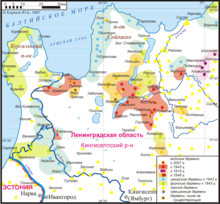Ischoric language

| Ingrian (ižoran keeli) | ||
|---|---|---|
|
Spoken in |
Russia | |
| speaker | 302 ( 1989 ) | |
| Linguistic classification |
|
|
| Language codes | ||
| ISO 639 -1 |
- |
|
| ISO 639 -2 |
fiu (other Finno-Ugric languages) |
|
| ISO 639-3 |
izh |
|
Ischorisch (also: Ishorisch ; ižoran Keeli ), according to the geographical area Ingermanland also Inger manic or Ingrisch , is a high-risk language from the finno-Ugric language family .
In 1989 there were still 302 people who mastered Ischoric as their mother tongue. The speakers belong to the small people of the Ischors ( Ingrians ) who live in Leningrad Oblast west of Saint Petersburg . A short-lived written language existed in the 1930s, but was not supported by the then Soviet Union . Ischorian is most closely related to Finnish and Karelian .
Ingrian or Ischoric
The term commonly used Ingrian language can be misleading because sometimes as Ingermanlandians designated Protestant Finns of Russia as Ingrians be called; however, they speak Finnish or Russian .
Web links
Individual evidence
- ↑ For example with Paul Ariste: The ways of the extinction of two Finnish-Ugric languages. 1970; Iris Audova: The Baltic Finnish deverbativa on * -ba / -pä and * -ja / -jä in the function of the adjectival attribute. In: Linguistica Uralica 2003 / I, p. 13; Liivi vanasonad Vol. 1. Eesti Raamat 1981, p. 79; Etc.